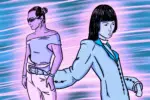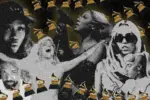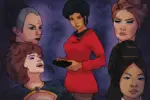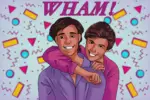Born in the early 80s, I spent much of my childhood submerged in a culture that was in love with questionable hairstyles. The “Flock of Seagulls” involved a high pompadour pushed down in front, creating an iconic silhouette that remains difficult to forget. Dee Snyder of Twisted Sister rocked blond curls like no girlfriend of mine ever could. But the hairstyle I can always see the most clearly in my mind’s eye is the infamous mullet. “Cut the sides, don’t touch the back,” the 1994 Beastie Boys sing in their 1994 song, “Mullet Head.” Their lyrics described the hairstyle itself, and they went on to detail the style further in their magazine, “Grand Royal.” In doing so, the Beastie Boys put a name to the popular hairstyle that was worn across the world in the 80s and early 90s. Today, the mullet, which has remained popular in Australia since the 80s, is regaining popularity in the United States.
I grew up around mullets during my early childhood. My Aunt Lisa, an important nurturing figure in my youth, was a strong, intelligent woman who always had some type of mullet. Her hair might be cut into a short mullet with highlights, or a long mullet with layers, but her lovely blonde hair was always shorn short in the front. It marred the smoothly flowing curtain of yellow, and I always wondered why she chose such an ugly haircut. It wasn’t until I was much older and understood the mullet’s cultural significance during the late 80s and early 90s that I finally understood my aunt and her chosen haircut. Hairstyles have been used for centuries to signify class, race or cultural differences, and the mullet’s history begins far earlier than the 1980s.
As far back in history as the Roman Empire, tribal peoples were known to wash and style their hair in ways commonly found outside a modern punk club. When the Romans first encountered the Ancient Britons, a wave of warriors with bleached blonde liberty spikes greeted their arrival. A metal figure depicting an Ancient Briton dating back to the Roman occupation of Britain in the first century A.D. possesses a hairstyle similar to a modern mullet. The mullet may have been around longer than the Latin language.
Many different tribes that traveled the Asiatic Steppes are known to have sported their own cultural forms of extreme hairstyles. For example, the Mongols are known to have cut and styled their hair or shaved their heads to create formidable hairstyles that would look standard on singers in death metal bands. The Huns, precursors to the Mongols, were a nomadic tribe of the Asiatic steppe famously known for raiding Roman lands under King Atilla. A sixth-century Byzantine scholar described the haircut of a young man that is worn long in the back and cut short in the front as “Hunnic.” Given how the hairstyle was used culturally in the 70s, 80s and 90s— as a part of punk and metal subcultures— the badass characterization of the mullet remained intact.
In the 1970s, rockers were the first to push hairstyle boundaries with mullets. David Bowie and Rod Stewart, sex symbols during their heydays, both had mullets. The drummer from Rush, Neil Perth, opened the mullet door for straight men. And as rock stars pushed the boundaries of style, the mullet became a more popular hairstyle among the fashionable. As the 80s commenced, the mullet was everywhere. Every “cool” man sported a mullet paired with blade sunglasses. In 1987, Kiefer Sutherland and his bleach-blonde mullet famously starred in the seminal comedy horror “The Lost Boys,” effectively solidifying the fabulousness of the mullet in pop culture across the country. The way America viewed hair would never be the same.
This robust, living history was unknown to me as a child. All I knew was that I hated my aunt’s hairstyle. What I didn’t know was that my Aunt Lisa was part of a subculture across America that was being persecuted and killed, even though she lived her life quietly. It was not safe for her to openly express who she was because of the threat of violence against her and her loved ones. My aunt grew up gay in America. She learned from an early age that it was not safe for people to know about her sexuality, her home life or her family. I remember as a child having to lie about how I was related to her when questioned by her coworkers because I was the niece of her partner, and it was not safe for her employers to know she was a lesbian.
Even when a person is trying to “pass” in society, they and their subculture often create signs and symbols to visually identify themselves to one another without explicitly “outing” themselves. My aunt’s mullet was a sign of her identity as a lesbian and belonging in the LBGTQ+ community. Her haircut was a rejection of traditional feminine beauty standards and a representation of her otherness. While I didn’t appreciate that aspect of her haircut as a child, now I can see and appreciate her strength in accepting and loving herself despite the challenges she faced. Her warrior goddess haircut was a testament to her battle-worthiness.
Today, mullets have grown in popularity again, but not for the same cultural reasons. The digital age has brought us closer together and made communication so fast and easy that trends can explode at an incredibly rapid pace. The mullet began its glorious comeback in America as an ironic joke by the characters Kenny Powers in “Eastbound and Down” and Brock Sampson in “Venture Brothers” but has gained an unironic following among the likes of Miley Cyrus, Rihanna and Zendaya. The mullet continues to be used as a powerful anti-assimilation signal, or, as the Beastie Boys put it, “a hairstyle that’s a way of life.”
















